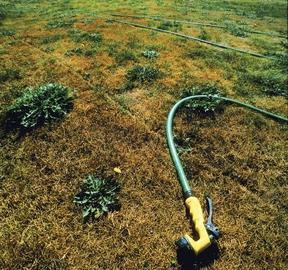The south of England is facing its most serious drought for 100 years, which could have serious consequences for the industry.
After 16 months of dry weather, the south of England is experiencing low groundwater levels. This could result in the most serious drought to affect the south of England in the last 100 years. Three water companies – Sutton and East Surrey Water, Southern Water and Mid Kent Water – have applied to the Secretary of State for a total of four drought orders to limit or prohibit non-essential uses of water and Thames Water is currently in the process of applying. All four drought orders were granted in May 2006 and allow the water companies in question to restrict the uses of water as listed in the Drought Direction 1991, which goes further than a mere hosepipe ban.
The current water situation in the south of England could have serious implications for the building industry as regards both the construction and subsequent operation of buildings. In addition, pressure on water resources and infrastructure can only increase as London’s population is set to expand by 800,000 over the course of the next 10 years.
During extended periods of low rainfall, there are three escalating levels of restrictions that may be placed on water use.
1) Basic – hosepipe bans
Water companies may, under the Water Industry Act 1991, impose a ban on the use of hosepipes to wash private cars or water private gardens. Water companies do not require permission from the government or the Environment Agency to impose such a ban. Hosepipe bans are currently affecting around 13 million people, but have little or no impact on the construction industry.
2) Intermediate – drought orders
Ordinary drought orders may be granted where there is an exceptional shortage of rain, meaning that a serious deficiency of water supplies exists or is threatened. These permit water companies to impose restrictions on non-essential uses of water for purposes such as garden watering, filling private swimming pools, cleaning building exteriors, cleaning industrial premises plant (other than for safety and hygiene); and operating ornamental fountains.
3) Severe – emergency
Drought orders
Emergency drought orders may be granted where the deficiency of water supplies is likely to impair the economic or social wellbeing of people in the area. Under these orders, water companies may prohibit or limit the use of water for such purposes as they think fit – even restricting supply water to standpipes only.
These clearly have the potential to affect the construction industry, as they may prohibit or limit the use of water on construction sites.
Contravention of a drought order is an offence which may result in a fine of up to £5,000 in the Magistrates Court, or an unlimited fine in the Crown Court.
A twin track approach to water resources is being taken in terms of demand management and water resource development to ensure the long-term security of our water supply. Various initiatives currently exist to promote the use of water efficient appliances and equipment for buildings, including campaigns by water companies to promote the careful use of water.
The construction industry should play its role through the specification and installation of more water-efficient appliances. The Government’s Water Technology List (WTL) provides information on appliances and equipment that are efficient and benefit from eligibility for Enhanced Capital Allowances (ECA) in certain circumstances. In addition, the Market Transformation Programme (MTP), managed by DEFRA’s Environment, Business and Consumers Division, supports the development and implementation of UK government policy on sustainable products. It is actively involved in assessing water using appliances and assisting in bringing forward water efficient products.
Water companies are improving infrastructure which will reduce losses through leakage. For example, Thames Water is investing £500,000 per day until 2010 to reduce leakages. 215 km of mains have been replaced in 2005/06. However, leakage remains a problem and it still loses 894 million litres a day. Earlier this year, it was revealed that Thames Water had missed its leakage reduction target set by Ofwat for the third year in a row.
In terms of developing new resources, Thames Water is investigating the building of a desalination plant and the possibility of a major new reservoir in Oxfordshire. Water companies are generally reported to be spending £16m on engineering schemes in the short term and are prepared to spend a further £555 m on longer term measures which will require substantial amounts of engineering and construction work.
In the future, water resources must be considered as part of the planning and development process to ensure the sustainability of local developments and implementation of regional growth policies. It can no longer be taken for granted and action is crucial in the south of England.
Source
Building Sustainable Design
Postscript
Tom Pedder is a solicitor with law firm Macfarlanes. Martin Shouler is leader of Arup’s environmental services engineering division.























No comments yet